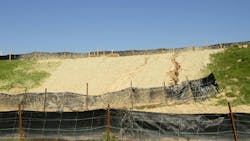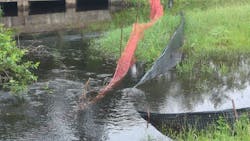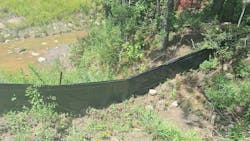Stormwater management in transportation projects
Key Highlights
- Transportation projects require comprehensive environmental studies under NEPA to identify impacts and develop mitigation strategies.
- Stormwater management challenges vary significantly based on geographic factors such as climate, topography, and local flora and fauna.
- Structural controls and BMPs must be designed and maintained considering local weather patterns, terrain, and potential extreme events like flooding and snowmelt.
Transportation projects, whether developing a new highway, or expanding an existing highway, are necessary to increase or improve transportation infrastructure to meet population growth demands, increase traffic safety, and support commerce across the country. The planning and execution of these projects pose many environmental challenges and can have socio-economic impacts such as traffic and business interruption.
Required studies guide stormwater management
During the planning phases, studies must be completed to identify the potential environmental and socio-economic impacts of the project with the intent of identifying mitigation strategies and alternatives that will minimize these effects – a significant goal in the National Environmental Policy Act (NEPA) process.
These studies are required of departments of transportation (DOTs) and transit agencies under NEPA. Known as an “umbrella law,” NEPA provides the framework for compliance with all environmental laws, which cover a multitude of regulations including the Endangered Species Act (ESA), the Migratory Bird Treaty Act (MTBA), the Clean Water Act (CWA), the Clean Air Act (CAA) and many more. Many different federal and state agencies are responsible for administration and enforcement of these regulations authorized under various federal statutes.
The findings coming out of the NEPA process result in a host of issues to be addressed before the project can receive approval and final clearance begin. The agency owning the project, also known as the sponsoring agency under the NEPA process, is required to make commitments to mitigate the environmental impacts as a condition of obtaining clearance for the project. In addition to managing stormwater runoff, specific commitments might include reducing greenhouse gas emissions, managing hazardous waste, avoiding tree clearing during bird nesting season, implementing erosion control measures, and preserving cultural resources. These commitments are incorporated into the project design plans as Environmental Project Issues and Commitments (EPIC) and are required to be enforced during execution of the project.
There are common challenges with stormwater-related impacts during the execution of transportation projects in addressing the environmental concerns, their mitigation strategies and fulfilling EPIC commitments that came out of the planning phase.
Impacts and their management
Meeting the environmental issues and commitments as a condition of receiving clearance for the project becomes a challenge itself as climate, physical conditions, and other variables negatively impact the project schedule and the effectiveness of the mitigation strategies employed.
Although common themes exist across transportation projects, the execution of each project is unique in its footprint, geographic location, alignment, and local impacts, especially those challenges related to managing stormwater runoff. The implementation and maintenance of sediment and erosion structural controls are common stormwater-related challenges. While there are an abundance of sediment and erosion structural controls and best management practices (BMPs) available in the market for managing stormwater on highway construction projects, many factors affect the condition, structural integrity, and effectiveness of these controls and BMPs.
Factors, such as local climate with respect to average annual rainfall, topography, hydrology, ecoregion, diversity of local flora and fauna, and geology, can present favorable or unfavorable conditions for implementing and maintaining appropriate BMPs and structural controls. The state of Texas, for example, is generally divided into 10 ecoregions, each somewhat characteristically different in soil composition, average annual rainfall, unique local flora and fauna, and topography according to the Texas Parks and Wildlife Department (TPWD, 2025). These differences can pose a variety of challenges for stormwater management, erosion and sediment controls.
For example, the east Texas Piney Woods is subject to 36 to 50 inches of rain annually on average while characterized by rolling terrain covered by pines and oak trees and elevations of 200 to 500 feet above mean sea level. Therefore, a Texas Department of Transportation (TxDOT) project in east Texas can be subject to high volumes of stormwater runoff and stormwater run-on with higher velocities than a project in the Texas Gulf Prairies and Marshes where the topography is relatively flat, has elevations nearly at sea level and poor drainage with reduced velocities although the volume of water managed can be similar due to the average annual rainfall being similar.
The high volumes of stormwater runoff with increased velocities resulting from the rolling terrain in east Texas pose a real challenge for the implementation and maintenance of sediment and erosion structural controls and other BMPs in that part of the state due to the potential for flash flooding conditions. The structural integrity of the BMPs can become compromised if a significant storm event destroys them, which requires a total replacement. Other BMPs commonly collapse and/or become submerged on a frequent basis depending solely on local weather patterns. A check on these will determine if they have maintained their structural integrity after the water recedes or if time is needed to evaluate their integrity and/or if maintenance is required.
While the Texas Gulf Prairies and Marshes also receive an average of 30 to 50 inches of rainfall per year, the topography creates slightly different challenges; some characterized by a delay between the time the rainfall occurs in a drainage area and when the runoff begins. This often results in delayed flooding conditions which completely submerge BMPs for longer periods of time. These challenges are expected to be like the challenges faced by the Louisiana Department of Transportation and Development (LaDOTD) in southwest Louisiana where elevations are virtually at sea level and annual rainfall totals regularly exceed 50 inches annually just like the Texas Gulf Prairies and Marshes.
On the western coast of the United States, The California Department of Transportation (Caltrans) is faced with a different set of challenges during large highway projects that transact vast areas.
Yuba County California, located at the slope of the Sierra Nevada for example, covers large, changing elevations as the north-central Central Valley varies in elevations ranging from 50 feet to 4,828 feet at Sugar Pine Peak (Caltrans State Route 70 EIS Report 2024). A Caltrans transportation project in Yuba County (Caltrans State Route 70 EIS Report 2024) also experienced challenges in the implementation and maintenance of stormwater, sediment and erosion controls, including major flooding caused by increased runoff velocities flowing from the higher elevation areas and sometimes snowmelt flowing from the mountains in the spring, thus, submerging or destroying BMPs and stormwater management structural controls.
While the annual average rainfall in Yuba County is approximately only 20 inches per year, the terrain, the elevations, and the project proximity to both the Yuba River and the Feather River, pose a challenge in managing the stormwater runoff and snowmelt while protecting the structural controls and BMPs.
While Washington State Department of Transportation (WSDOT) faces many of the same challenges as other DOTs across the country, WSDOT also has challenges unique to its geography. One such project is the 15-mile stretch of I-90 located in Kittitas County, Washington, where the project faced multiple environmental and design challenges due to its alignment along a high mountain pass in the Central Cascades (WSDOT EIS, 2008). The project is in an area that receives high volumes of stormwater and heavy snow at times, which requires specialized designs to manage stormwater runoff, stormwater run-on, as well as snow melt. Some of the project areas are susceptible to rockslides and avalanches as well, presenting an additional set of challenges for maintaining stormwater structural controls and BMPs.
The public perception factor
Structural control failures and reduced BMP effectiveness caused by uncontrollable factors place a financial burden on DOTs across the country. The public typically has low awareness of these financial impacts and high awareness of the impacts visible to them — those to the environment, which is very visible following a significant rainfall event that destroys the structural controls, and those to their community, which can include increasing traffic that sometimes affects businesses located along the affected corridor. These factors can attract negative attention during public comment periods. Managing public perception is essential to preserving the integrity of the project and the public image of the DOT.
DOTs across the country have a substantial responsibility with the purpose of maintaining and improving the country’s transportation infrastructure to increase traffic safety, increase capacity to meet population growth demands and to support commerce. DOTs are mandated to conduct their business in a responsible manner while being good stewards of the environment and minimizing impacts to communities and to the natural and cultural resources identified during the planning studies under the NEPA process. Continuous monitoring, correction of infractions and specialized mitigation designs as needed for unique climate and geographical impacts are all essential to meeting this obligation.
About the Author
Ralph Calvino
Ralph Calvino REM, CPESC, CESSWI, is a Senior Associate serving as Terracon’s Regional Manager of Environmental Services for Southeast Texas, while supporting the Regulatory Compliance practice across the State of Texas and beyond. His 30 years of experience includes over a decade in state government and 22 years in various consultant roles including Project Director and Stormwater Technical Practice-Group Leader at a Fortune 500 Global Firm.




